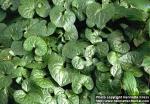Related entry: Asarum.—Wild Ginger
The rhizome and leaves of the Asarum Europaeum, Linné.
Nat. Ord.—Aristolochiaceae.
COMMON NAMES: Asarabacca, Hazlewort, Wild nard.
Botanical Source.—This plant has a creeping root or rhizome, entangled with numerous stout, branching fibers. The stems are very short, simple, round, herbaceous, pubescent, each bearing 2 dark-green, shining, reniform, obtuse, entire, somewhat downy leaves, which are opposite, 2 inches wide, on long, downy, footstalks; also, 1 drooping flower, not an inch long, fleshy, of a dusky-purple color, placed upon a short terminal peduncle. The calyx is campanulate, greenish at the base, divided into 3-pointed, purplish segments, which are erect and turned inward at their extremity. The corolla wanting. The fruit is a 6-celled, coriaceous capsule, crowned with the persistent calyx.
Description and History.—The root is ash-colored, 2 or 3 lines in thickness, 4-angled, contorted, rough; has a pepper-like odor, a biting, spicy taste, and yields an ash-colored powder. Its properties are taken up by water or alcohol; boiling evaporates and age impairs them. The leaves have virtues similar to those of the root; they have a very feeble odor, a taste like that of the root, with some bitterness, and produce a green powder, having a yellow tinge. Asarabacca is a European plant, growing in moist, hilly woods, and presenting a single, bell-shaped, dingy-brownish-red flower from May to August. The root and leaves are used in medicine, and when recent are quite acrid. They should always be carefully dried for preservation.
Chemical Composition.—Graeger has found in the root volatile oil, asarum camphor (C20H26O5) (asaron), asarit, asarin, tannic acid, resin, starch, extractive, gluten, albumen, various salts, etc.; in the herb, asarin, tannic acid, extractive, citric acid, chlorophyll, etc. (P.). The substances designated by Graeger as asarum camphor and asarit, were subsequently shown to be identical in chemical composition, differing only in their physical properties, the former being at first an oily liquid, which afterwards crystallizes in scale or needles from an aqueous distillate, and the latter acicular crystals, precipitated from the same. Asarin, a yellow body, gives to this drug its bitterness. It is probably identical with the cytisin of Lassaigne and Fenuelle. The yield of oil is about 1.0 per cent. It has an odor resembling valerian, is yellow, viscid, and has a pungent, burning taste. According to Schimmel & Co. (Semi-Annual Report, October, 1893), its specific gravity, at 15° C. (59° F.), ranges from 1.046 to 1.068, and its known constituents are asarone, pinene, and eugenol-methyl-ether. The chemistry of asarone was investigated in detail by Rizza and Butlerow, in 1884 and 1888.
Action, Medical Uses, and Dosage.—Asarabacca produces nasal irritation, followed by free secretions, which flow persistently. It is emetic, cathartic, and errhine. Used principally as an errhine in certain affections of the brain, eyes, face, and throat, toothache, ophthalmia, and paralysis of the mouth and tongue. Internally it is a stimulant in doses of 10 or 12 grains; and an emetic in ½ drachm or 1 drachm doses. It is said to be used in France by drunkards to produce vomiting.
 Related Species.—Asarum Sieboldii, Miquel. This plant is the to-sai-shin of the Japanese. The rhizome is slender, stem-scarred, and has attached to it thick, tufty aggregations of long, light-brown rootlets. These are white and mealy internally, surrounding a yellow, woody cord. It has an aromatic fragrance, and the taste resembles the combined flavors of sassafras and nutmegs, followed by an irritating pungency. It grows in Japan.
Related Species.—Asarum Sieboldii, Miquel. This plant is the to-sai-shin of the Japanese. The rhizome is slender, stem-scarred, and has attached to it thick, tufty aggregations of long, light-brown rootlets. These are white and mealy internally, surrounding a yellow, woody cord. It has an aromatic fragrance, and the taste resembles the combined flavors of sassafras and nutmegs, followed by an irritating pungency. It grows in Japan.

